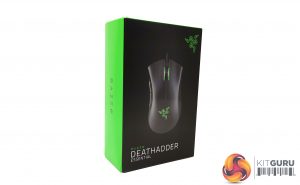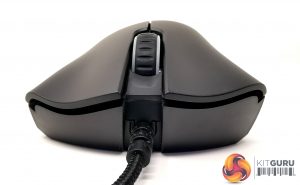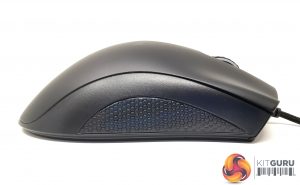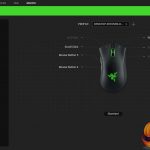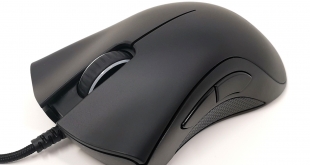
Razer has long been known for its premium, feature packed mice, with very few alternatives for the budget consumer. This began to change with the introduction of its Essential Gaming line, seeing the release of the Razer Abyssus Essential earlier this year. Now, the company has given its famous DeathAdder range the same treatment – but can the DeathAdder Essential compete in a market already oversaturated with budget offerings?
When we reviewed the DeathAdder Elite back in 2017, our primary criticism was its £70 price point being a little on the expensive side. Razer seems to have taken on-board this feedback, scaling back the extra buttons and RGB lighting in favour of a more accessible £49.99.
Specifications:
- Dimensions: 73 x 43 x 127 mm (W x H x D)
- Weight: approx. 96g (excluding cable)
- Colour: Black
- Layout: Right-handed operation
- Buttons: 5 (incl. mouse wheel button)
- Sensor Resolution: max. 6,400 DPI
- Acceleration: max. 30 G
- Microswitch: Razer Mechanical Mouse, min. 10 million clicks
- Connection: USB
- USB Signal Rate: 1,000 Hz
- Cable Length: 1.8 m (coated)
- Lighting: Single-colour green
- Compatibility: Windows 10, 8/8.1 and 7 (software)
- Guarantee: 2 years
The Razer DeathAdder Essential ships in a professional-looking black box, accented by Razer’s signature green colour scheme. The mouse takes centre stage, surrounded by the company’s snakehead logo and unique font.
Looking at the back of the box gives a quick peek at what the mouse is about, boiling things down to performance, ergonomics and Razer’s own Hyperesponse switches, three key selling points that we will touch on later.
As a right-handed mouse, the DeathAdder Essential retains the same curvaceous form seen on Razer’s premium DeathAdder, noticeably stripping the DPI buttons from below the scroll wheel. Both the left and right switches dip into the mouse, an ergonomic choice intended to naturally cushion the user’s hand.
The scroll wheel houses two LED strips either side of the indented rubber grip, acting as a fifth button when pressed. The lighting is synced with the LEDs beneath the snakehead logo on the mouse’s rear, each shining Razer’s emerald green.
Razer takes a minimalistic approach to the DeathAdder Essential with little on the right hand side apart from a rubber pinky grip. The same textured padding is on the left side of the mouse, located below the chunky back and forward buttons.
All of the relevant product information can be found on the underside of the mouse, surrounding the 6,400 DPI sensor. The black coated cable is the same premium quality found on all of Razer’s modern peripherals, with a branded USB connector sporting the company’s font and colour.
The Razer DeathAdder Essential has been tested for a month across editing photos, browsing the web and gaming across multiple genres.
Razer’s proprietary Synapse software automatically downloads upon plugging the mouse into a system, allowing users to customise macro profiles, rebind switches and connect to Philips Hue devices. The program is split across five tabs, called Synapse, Mouse, Profiles, Hue and Macro from left to right.
The ‘Synapse’ tab splits itself into two sub-categories: a general dashboard and modules. The modules sub-category is largely redundant for two reasons: its library simultaneously appears on the dashboard alongside other online services and each module only serves as a hyperlink to other areas within the software. This would be beneficial, had Synapse been complicated to use, but its simplistic nature doesn’t need multiple ways to navigate.
The ‘Mouse’ tab is one of the more handy options offered within the software, allowing users to see a diagram of button allocation, customise keybindings and check out Razer’s Hypershift – a fancy name for a secondary profile users can switch to on-the-fly for double the functionality. DPI sensitivity and polling rate can be changed under performance, and perhaps my favourite feature is Razer Synapse linking directly to Windows Mouse Properties. This is perfect for turning off that pesky “mouse acceleration” option for gamers.
The ‘Profiles’ tab displays any Razer device the user owns, as well as the different profiles allocated to each game. This ties directly to the ‘Macro’ tab, which is unsurprisingly the go-to place for owners to setup their own macros and bind them to specific profiles. This can be relatively fiddly in comparison to other software I’ve used, but Synapse 3 does seem to be much better than previous iterations.
At its brightest, the green lighting on the Razer DeathAdder Essential’s two core zones is incredibly vibrant, while its lowest is still quite crisp. The option to switch the lighting off isn’t too clear, being placed as a toggle switch next to “brightness;” however this subtle approach does lend to the sleek layout. Alternatively, users can set a timer between 1 and 15 minutes to turn the lighting off when idle, perfect for watching movies.
The 96g of the Razer DeathAdder Essential is relatively run-of-the-mill, fitting in the “Light-Middle” category of mice. While this has been shown to be ideal for a good portion of gamers, I’m personally used to much heavier devices which resulted in a small adjustment period. Despite this difference, I found the contoured shape perfect for my palm grip while gaming. I can’t imagine claw-grip users would have much trouble with the shapely mouse either, as KitGuru’s Dominic Moass describes the near-identical shape of the Elite version to be “very comfortable.”
The switches are Razer’s own mechanical variants made in collaboration with Omron, carrying an industry rating of 10 million clicks instead of the Elite’s reported 50 million. There is a distinctly deeper sound in Razer’s offering than Omron switches, which is particularly loud when using the ‘back’ and ‘forward’ buttons but satisfying to press thanks to the tactile feel. The removal of the extra buttons below the scroll wheel is jarring, making it so that the user can’t switch DPI on-the-fly.
It’s not clear what sensor Razer has chosen to use on its DeathAdder Essential, with the Elite previously opting for a top of the line PMW 3389. The Essential is not as sensitive as its bigger brother, dropping from a relatively unnecessary 16,000 DPI to True 6,400 DPI. I had no trouble gliding the mouse smoothly thanks to the three rubber feet, with no jitter or drag on a variety of cloth and hard surfaces.
The design of the Razer DeathAdder Essential gaming mouse is undoubtedly comfortable, although the lack of features does leave a bit be desired at its particular price point.
Each click feels satisfying, especially so when the DeathAdder Essential is used in more intense competitive games such as first-person shooters. The matte black plastic housing helps to highlight the emerald green LED lighting, ensuring aesthetic appeal. While RGB would be a nice addition, it is certainly worth the sacrifice to drive the price down.
I’m not so keen on the lack of on-board DPI switch. Some gamers will find the inability to switch DPI on-the-fly quite annoying, while others might praise that there's no chance of accidentally hitting it mid-game. For me, I use the DPI button all the time, so speaking personally this isn't a change that is worth the £20 saving when compared with the Elite. You can of course adjust the DPI within the Synapse software, but this can prove tedious for those that regularly use the function.
Although I do think there are a lot of repeated and therefore redundant options in Synapse, the software does offer a lot in contrast to much of the competition. As I mentioned earlier, linking directly into the Windows Mouse Settings could prove useful for those caught out by awful mouse acceleration.
Overall, reducing the price has certainly come at some necessary expenses, but it seems as though valued features might have been caught in the crossfire. Considering competition from Logitech’s G502 offers a DPI switch, extra buttons, RGB lighting, adjustable weights and the ability to unlock the scroll wheel for the same price as the DeathAdder Essential, it can make Razer’s device harder to recommend.
Those wanting to purchase immediately are perhaps better off taking advantage of the DeathAdder Elite, currently on sale at Overclockers UK for the same price HERE. Assuming that this deal is temporary, the DeathAdder Essential still retains a premium feel thanks to Razer’s signature design, and proves better in value than the previous Abyssus Essential thanks to the inclusion of side buttons.
Razer’s DeathAdder Essential is readily available at Overclockers UK for £49.99 HERE.
Pros
- Comfortable design.
- Expansive Synapse software.
- Tactile switches.
- Vibrant lighting.
Cons
- Still expensive for a budget option.
- No RGB lighting.
- Lacking DPI switch.
KitGuru Says: Razer’s signature design remains comfortable, sleek and minimalistic. £50 is still a decent investment in a mouse and you will find more feature-rich offerings elsewhere, but those who want the DeathAdder shape without the bells and whistles of the Elite model will get on well with the Essential.
 KitGuru KitGuru.net – Tech News | Hardware News | Hardware Reviews | IOS | Mobile | Gaming | Graphics Cards
KitGuru KitGuru.net – Tech News | Hardware News | Hardware Reviews | IOS | Mobile | Gaming | Graphics Cards



